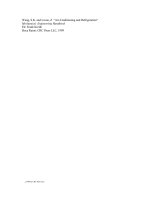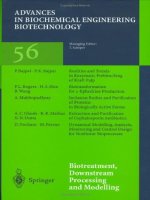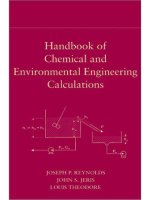fermentation and biochemical engineering handbook 2ed 1997 - vogel & todaro
Bạn đang xem bản rút gọn của tài liệu. Xem và tải ngay bản đầy đủ của tài liệu tại đây (34.38 MB, 829 trang )
FERMENTATION AND
BIOCHEMICAL E NG
I
N
E E
RI
N
G
HANDBOOK
Principles, Process Design, and Equipment
Second
Edition
Edited by
Henry C.
Vogel
Consultant
Scotch Plains, New Jersey
and
Celeste
L.
Todaro
Heinkel Filtering Systems, Inc.
Bridgeport,
New Jersey
NOYES
PUBLICATIONS
Westwood,
New
Jersey,
U.S.A.
lnpl
Copyright
8
1997 by Noyes Publications
No part of this book may be reproduced or utilized
in any form or by any means, electronic or
mechanical, including photocopying, recording or
by any information storage and retrieval system,
without permission in writing from the Publisher.
Library of Congress Catalog Card Number: 96-29055
Printed in the United States
ISBN:
0-8
155-1407-7
Published in the United States of America by
Noyes Publications
369 Fairview Avenue, Westwood, New Jersey.07675
10 9
8
76
5
43
2
1
Library of Congress Cataloging-in-Publication Data
Fermentation and biochemical engineering handbook.
2nd ed.
/
edited
by Henry C. Vogel and Celeste L. Todaro.
p.
cm.
Includes bibliographical references and index.
1.
Biochemical engineering Handbooks, manuals, etc.
ISBN 0-8155-1407-7
2. Fermentation Handbooks, manuals, etc.
I.
Vogel, Henry C.
11.
Todaro, Celeste L.
TP248.3.F74 1996
660'.28449 d~20 96-29055
CIP
DEDICATION
For
my parents, Ernest and Charlotte Todaro,
whose pursuit
of
knowledge inspired me and
continues
to
do
so.
Preface to the
Second Edition
The second edition ofthe
Fermentation andBiochemica1 Engineer-
ing
Handbook,
like the previous edition, is intended to assist the develop-
ment, design and production engineer who is engaged in the fermentation
industry. Particular emphasis is give to those unit operations most frequently
encountered
in
the commercial production ofchemicals and pharmaceuticals
via fermentation, separation, and purification.
Some theory is included to provide the necessary insight into the
unit operation but is not emphasized. Rather, the emphasis is placed on
the practical aspects of development, design and operation-how one
goes about collecting design data, what are the scale-up parameters, how
to select the right piece of equipment, where operating problems arise,
and how to troubleshoot.
The text is written from
a
practical and operating viewpoint, and
all
of the contributing authors have been chosen because of their
industrial background and orientation. Several of the chapters which
were in the first edition have been either deleted or replaced by other
chapters which are more germane to current fermentation practice.
Those chapters which were retained have been updated or have been
rewritten to reflect current practice. Several new chapters were intro-
duced to reflect current emphasis on cell cultures, nutritional require-
ments, statistical methods for fermentation optimization, cross-flow
filtration, environmental concerns, and plant design
vi
Preface to the Second Edition
vii
The editors wish to express their gratitude to Mrs. Connie Gaskill
of
Heinkel Filtering Systems, Inc., for the wordprocessing assistance she
gave to this edition.
Scotch Plains, New Jersey
Bridgeport, New Jersey
September,
1996
Henry C. Vogel
Celeste
L.
Todaro
Preface to the
First Edition
This
book is intended to assist the development, design and produc-
tion engineer who is engaged in the fermentation industry. Particular
emphasis is given to those unit operations most frequently encountered in the
commercial production of chemicals
and
pharmaceuticals via fermentation,
separation, and purification.
Some theory is included to provide the necessary insight into the unit
operation but is not emphasized. Rather, the emphasis
is
placed on the
practical aspects of development, design and operation-how one goes about
collecting design
data,
what are the scale-up parameters, how to select the
right piece of equipment, where operating problems arise and how to
troubleshoot.
The text
is
written from
a
practical and operating viewpoint, and
all
of the contributing authors have been chosen because of their industrial
background and orientation. Since the handbook concerns fermentation and
often the engineers involved in fermentation are not versed in microbiology,
it was thought advisable to introduce this subject at the beginning ofthe book.
Similarly, since much of fermentation deals with the production of antibiot-
ics, it was deemed advisable to include some chapters specifically oriented to
the production of sterile products.
The engineering using
this
handbook may wish that other unit
operations or different pieces of equipment had been included other than those
viii
Preface to the First Edition
ix
selected. The selection was based on the individual contributors and my
own
experience, over many years
of
work in the field, with unit operations and
pieces
of
equipment that have been the backbone and workhorses of the
industry.
The
editor wished to express
his
thanks to Mr. Stanley Grossel of
HofEnann-La Roche and Mr. John Carney
of
Davy McKee Corporation for
reviewing and editing the draft copies. He also
thanks
Miss Mary Watson
of
Davy McKee Corporation for typing assistance,
and
Mr. Michael Garze of
Davy McKee Corporation for
his
help in producing many
of
the graphs and
illustrations. Dr. Sol Barer, the author ofthe microbiology chapter acknowl-
edges the valuable input to the Celanese Biotechnology Department, and
especially thanks Miss Maria Guerra for her patience in typing and retyping
the manuscript.
Berkeley Heights, New Jersey
June 1983
Henry C. Vogel
Contributors
Michael
J.
Akers
Eli Lilly and Company
Indianapolis,
IN
Giovanni Bellini
3V
Cogeim S.P.A.
Dalmine, Italy
Ramesh R. Bhave
U.S. Filter Corporation
Warrendale, PA
Frederick
J.
Dechow
Biocryst Pharmaceuticals
Inc.
Birmingham,
AL
Barry Fox
Niro Inc.
Columbia, MD
Howard
L.
Freese
Allvac
Monroe, NC
Edwin
0.
Geiger
Pfizer Inc.
Groton,
CT
Stephen
M.
Glasgow
Union Carbide Chemical and
Plastics Co., Inc.
South Charleston,
WV
Elliott
Goldberg
Consultant
Fort Lee,
NJ
Yujiro Harada
K.
F.
Engineering
Co.,
Ltd.
Tokyo,
Japan
Willem Kampen
Louisiana State University
Agriculture Center
Baton Rouge, LA
Contributors xi
Mark Keyashian
CENTEON
Kankakee, IL
John
P.
King
Foxboro Company
Rahway, NJ
Maung
K.
Min
Gemini Management Consultants
New York,
NY
James
Y.
Oldshue
Mixing Equipment
Co.,
Inc.
Rochester,
NY
Laura Pellegrini
Politecnico di Milano
Milano, Italy
Russell
T.
Roane
Bechtel Engineering
San Francisco,
CA
Kuniaki Sakato
Kyowa
Hakko
Kogyo Co., Ltd.
Tokyo, Japan
Seiji Sat0
Kyowa Medex Co., Ltd.
Sunto-gun, Shizuoka Pref., Japan
Allan C. Soderberg
Fort
Collins, CO
Shinsaku Takayama
Tokai University
Numazu, Shizuoka Pref., Japan
Celeste
L.
Todaro
Heinkel Filtering Systems, Inc.
Bridgeport, NJ
David
B.
Todd
Todd Engineering
Princeton, NJ
Henry C. Vogel
Consultant
Scotch Plains, NJ
Mark R. Walden
Eli Lilly Company
Indianapolis,
IN
Curtis
S.
Strother
Eli Lilly Company
IndianaDolis.
IN
NOTICE
To
the best of our knowledge the information in this publication
is
accurate; however the Publisher does not assume any responsibility or
liability for the accuracy or completeness of, or consequences
arising from, such infomation.
This
book is intended for informational
purposes only. Mention of trade names
or
commercial products does
not constitute endorsement or recommendation for use by the
Publisher. Final determination ofthe suitability ofany information or
product for use contemplated by any user, and the manner of that
use, is the sole responsibility of the user. We recommend that
anyone intending to rely on any recommendation of materials
or
procedures mentioned in this publication should satisfy himself as
to such suitability, and that he can meet all applicable safety and
health standards.
Contents
1
Fermentation Pilot Plant
1
Yujiro Harada, Kuniaki Sakata, Seiji Sat0 and Shinsaku
Takayama
PROLOGUE (by Yujiro Harada)
1
1
.O
MICROBLAL FERMENTATION (by Kuniaki Sakato)
2
3
3
1.1
Fermentation Pilot Plant
1.2 Bioreactors and Culture Techniques
1.3 Application of Computer Control and
1.4 Scale-up
1.5 Bioreactors for Recombinant DNA Technolo
References (Section
1)
2.0
MAMMALIAN
CELL CULTURE SYSTEM (by
2.1 Introduction
25
2.2
Culture Media
2.3 Microcarrier Culture and General Contro
2.4 Perfision Culture Systems
as a
New
High
Density
for Microbial Processes
Sensing Technologies for Fermentation Process
8
Culture Technology
3
1
2.5 Sedimentation Column Perfision Systems
33
2.6
High
Density Culture Using
a
Perfision Culture System
with Sedimentation Column.
2.7 Acknowledgment
References
and
Bibliography (Se
xiii
xiv
Contents
3.0 BIOREACTORS FOR PLANT CELL TISSUE AND
ORGAN
CULTURES (by
Shinsaku
Takayama)
3.1 Background of the Technique-Historical Overview
.4
1
3.2 Media Formulations
3.3 General Applications
3.4 Bioreactors-Hardware Configuration
3.5 Bioreactor Size
3.6 Culture Period
3.7
Aeration and Agitation
3.8 Microbial Contamination
3.9 Characteristics
3.10 Manipulation
3.11 Scale-up Problems
3.12 Bioprocess Measure
References (Section 3)
55
2
Fermentation Design
67
Allan
C.
Soderberg
1
.O
INTRODUCTION
2.0
FERMENTATION DEPARTMENT, EQUI
AND SPACE REQUIREMENTS
2.1 The Microbiological
2.2 Analytical
S
2.3 Production:
2.4 Media Preparation or Batchin
2.5 The Seed Fermenter Layout
2.7 Nutrient Feed
Tanks
2.8 Sterile Filters
2.9 Air Compressors
2.10 Valves (To Maintain Steril
2.11 Pumps 78
2.12 Cooling Equipment
2.13 Environmental Control
2.6 The Main Fermenter Layout
74
3
.O
GENERAL DESIGN DATA
4.0 CONTINUOUS STERILIZERS
4.1
A
Justification for Continuo
4.2 Support Equipment for a
St
4.3 The Sterilizing Section
4.4 The Cooling Section
79
5.0
FERMENTER COOLING
Contents
xv
6.0
THE DESIGN OF LARGE FERMENTERS
(BASED ON AERATION)
99
6.2
Fermenter Height
100
6.3
Mixing Horsepower by Aeration
10
1
by Agitators
and
Jets
107
6.7
Other Examples
of
Jet Airkiquid Mixing
109
6.8
Mechanical Versus Non-mechanical Agitation
1 10
7.0 TROUBLE SHOOTING IN A FERMENTATION PLANT
11 1
8.0
GENERAL COMMENTS
1
19
REFERENCES
120
6.1
Agitator Effectiveness
99
6.4
Air
Sparger Design
107
6.5
Comparison
of
Shear
of
Air
Bubbles
6.6
The Effect
of
Shear on Microorganisms
109
3
Nutritional Requirements in Fermentation
Processes
122
Willem
H.
Kampen
1
.O
INTRODUCTION
2.0
NUTRITIONAL REQUIREMENTS OF
THE
C
3
.O
THE CARBON SOURCE
4.0
THE
NITROGEN AND SULFUR SOUR
5.0
THE
SOURCE
OF
TRACE
AND
ESSENTIAL ELEMENTS
6.0
THE
VITAMIN SOURCE AND OTHER
GROWTH FACTORS
7.0 PHYSICAL AND IONIC REQUIREMENTS
8.0
MEDIA DEVELOPMEN
149
9.0
EFFECT OF NUTRIEN CENTRATION
GROWTH RATE
REFERENCES
159
4
Statistical Methods For
Fermentation Optimization
161
Edwin
0.
Geiger
1
.O
INTRODUCTION
16
1
2.0 TRADITIONAL ONE-VARIABLE-AT-A-TIME
METHOD
16 1
3
.O
EVOLUTIONARY OPTIMIZATION
162
4.0
RESPONSE SURFACE METHODOLOGY
166
mi
Contents
5.0
ADVANTAGES OF RSM
168
5.1 Maximum Information
from
Experiments
169
5.2
Forces One To Plan
170
5.3
Know
How
Long Project Will Take
170
5.4 Interaction Between Variables
170
5.5 Multiple Responses
5.6 Design Data
6.0 DISADVANTAGES OF RSM
7.0 POTENTIAL DIFFICULTIES
WITH
RSM
174
7.1 Correlation Coefficient
176
7.2 Regression Coefficients
7.3 Standard Error of the Regression Coefficient
176
7.4 Computed
T
Value
7.5 Standard Error
of
the Estimate
7.6 Analysis of Variance
177
8.0
METHODS
TO
IMPROVE
THE
RSM MODEL
178
9.0 SUMMARY
179
REFERENCES
179
5
Agitation
181
James
I:
Oldshue
1
.
0
THEORY AND CONCEPTS
2.0 PUMPING CAPACITY AND FLUID
SHEAR
RATES
182
3.0 MIXERS AND IMPELLERS
183
3.1 Fluidfoil Impellers
191
4.0 BAFFLES
201
5.0 FLUID
SHEAR
RATES
5.1
Particles
206
5.2 Impeller Power Consumption
207
5.3 Mass Transfer Characteristics of idfoil Impellers
217
6.1 Some General Relationships in Large Scale Mixers
Compared to Small Scale Mixers
6.2 Scale-up Based on Data from Existing
Production Plant
220
6.3 Data Based on Pilot Plant Work
223
6.4 Sulfite Oxidation Data
226
6.5 Oxygen Uptake Rate in the Broth
227
227
6.7 Reverse Rotation Dual Power Impellers
228
229
231
6.0 FULL-SCALE PLANT DESIGN
6.6 Some General Concepts
7.0 FULL SCALE PROCESS EXAMPLE
8.0
THE
ROLE OF CELL CONCENTRATION
MASS
TRANSFER RATE
Contents
xvii
9.0
SOME OTHER
MASS
TRANSFER CONSIDERATIONS235
10.0 DESIGN PROBLEMS
IN
BIOCHEMICAL
ENGINEERING
23 6
1 1
.O
SOLUTION-FERMENTATION PROBLEMS
238
LIST OF ABBREVIATIONS
240
REFERENCES
241
6
Filtration
242
1
.O
INTRODUCTION
242
243
2.0 CAKE FILTRATION
243
3.0 THEORY
3.1 Flow Theory
4.0 PARTICLE SIZE DISTRIBUTION
5.0
OPTIMAL CAKE THICKNESS
6.0 FILTER AID
247
7.0
FILTER MEDIA
8
.O
EQUIPMENT SELECTION
8.1 Pilot Testing
Celeste
L
Todaro
1.1
Depth Filtration
3.2
Cake Compressibility
244
10.1 Operation and Applications
258
11.1
Applications
11.2 Operation
260
11.3 Maintenance
264
12.0 HP-HYBRID FILTER PRESS
266
12.1 Applications
266
12.2 Operation
267
12.3 Maintenance
269
13.0 MANUFACTURERS
Rotary Drum Vacuum Filters
Nutsches
Hybrid Filter Press
REFERENCES
7
Cross-Flow Filtration
271
1
.O
INTRODUCTION
27 1
Ramesh R. Bhave
xviii
Contents
2.0 CROSS-FLOW VS. DEAD END FILTRATION
273
3.0 COMPARISON OF CROSS-FLOW
WITH
OTHER
COMPETING TECHNOLOGIES
4.2 Inorganic Microfilters and Ultrafilters
285
5
.O
OPERATING CONFIGURATIONS
289
5.2 Feed and Bleed
292
5.3
Single vs. Multistage Continuous System
297
6.0 PROCESS DESIGN ASPECTS
297
6.1 Minimization of Flux Decline With Backpulse
or Backwash
297
6.2 Uniform Transmembrane Pressure Filtration
300
6.3 Effect of Operating Parameters on Filter Performance
305
6.4 Membrane Cleaning
6.6 Troubleshooting
3 18
318
6.8 Safety and Environmental Consi
7.1 Clarification
of
Fermentation Broths
7.2 Purification
and
Concentration
of
Enzymes
323
7.3 Microfiltration for Removal
of
Microorganisms
7.4 Production of Bacteria-free Water
329
7.5 Production of Pyrogen-free Water
8.0 GLOSSARY OF TERMS
ACKNOWLEDGMENT
4.1 Polymeric Microfilters and Ultrafilters
28 1
5.1 Batch System
289
6.5 Pilot Scale Data and Scaleup
3 16
6.7 Capital and Operating Cost
7.0 APPLICATIONS OVERVIEW
or Cell Debris
AP-PENDIX: LIST OF MEMBRANE
MAN
(MICROFILTRATION AND ULTRAFILTRATION)
33 8
REFERENCES
343
8
Solvent
Extraction
348
1
.O
EXTRACTION CONCEPTS
348
2.0 DISTRIBUTION DATA
3.0 SOLVENT SELECTION
4.0 CALCULATION PROCEDURES
355
4.2 Sample Stage Calculation
360
363
DavidB. Todd
1.1 Theoretical Stage
4.1 Simplified Solution
5
.O
DROP MECHANICS
Contents
xix
6.0 TYPES
OF
EXTRACTION EQUIPMENT
366
6.1 Non-Agitated Gravity Flow Extractors
3 66
6.2 Stirred Gravity Flow Extractors
6.3
Pulsed Gravity Flow Extractors
37 1
6.4
Centnfbgal Extractors
373
6.5 Equipment Size Calculation
7.0 SELECTION OF EQUIPMENT
8.0 PROCEDURE SUMMARY
9.0
ADDITIONAL INFORMATION
REFERENCES
380
9
Ion
Exchange
382
Frederick
J.
Dechow
1
.O
INTRODUCTION
3 82
1.1 Ion Exchange Processes
383
384
2.0 THEORY
389
1.2 Chromatographic Separation
2.1 Selectivity
2.2 Kinetics
2.3 Chromatographic Theory
400
3.0 ION EXCHANGE MATERIALS
AND
THEIR PROPERTIES
407
3.1 Ion Exchange Matrix
407
3.2 Functional Groups
3.3 Porosity and Surface Area
3.4 Particle Density
418
3.5 Particle Size
4.0 LABORATORY EVALUATION
OF
RESIN.
5.0 PROCESS CONSIDERATIONS
426
5.1 Design Factors
5.2 Scaling-up Fixed Bed Operations
.
5.3 Sample Calculation
5.4 Comparison
of
Packed and Fluidized Beds
5.6 Pressure Drop
436
5.7 Ion Exchange Resin Limitations
5.8 Safety Considerations
6.0 ION EXCHANGE OPERATIONS
443
6.1 Pretreatment
445
6.2 Batch Operations
445
6.3 Column Operations
6.4 ElutiodRegeneration
45 8
7.0 INDUSTRIAL CHROMATOGRAPHIC OPERATIONS
,
,462
REFERENCES
470
5.5 Chromatographic Scale-up Procedures
xx
Contents
10
Evaporation
476
Howard
L.
Freese
1.0 INTRODUCTION
2.0
EVAPORATORS AND EVAPORATION SYSTEMS
3.0
LIQUID
CHARACTERISTICS
4.0 HEAT TRANSFER IN EVAPORATORS
5
.O
EVAPORATOR TYPES
5.1 Jacketed Vessels
49 1
5.2
Horizontal Tube Evaporators
493
5.3
Short-Tube Vertical Evaporators
5.4 Propeller Calandrias
494
5.5
Long-Tube Vertical Evaporators
494
5.6
Falling Film Evaporators
5.7
Forced Circulation Evaporators
497
5.8
Plate Evaporators
5.9 Mechanically Agitated %-Film Evaporators
5.10 Flash Pots
and
Flash Evaporators
5.11 Multiple Effect Evaporators
6.0
ENERGY CONSIDERATIONS FOR EVAPORATION
SYSTEM DESIGN
5
10
7.0
PROCESS CONTROL SYSTEMS FOR EVAPORATORS518
10.0 INSTALLATION OF EVAPORATORS
11 Crystallization
535
Stephen
M.
Glasgow
1.0 INTRODUCTION
2.0
THEORY
2.1 Field
of
Supersaturation
2.2
Formation
of
a Supersaturated Solution
2.3 Appearance
of
Crystalline Nuclei
2.4 Growth
of
Nuclei to Size
3
.O
CRYSTALLIZATION EQUIPMENT
54
1
3.1 Evaporative Crystallizer
3.2 Vacuum Cooling Crystallizer
545
3.3 Cooling Crystallizer
3.4 Batch Crystallization
4.0 DATA NEEDED FOR DESIGN
544
546
Contents
xui
5.0
SPECIAL CONSIDERATIONS FOR
FERMENTATION PROCESSES
547
5.1
Temperature Limitation
547
5.3
Long Desupersaturation Time
5.4
Slow
Crystal Growth Rate
6.0
METHOD OF CALCULATION
7.0
TROUBLESHOOTING
7.1
Deposits
551
7.2
Crystal
Size Too Small
552
7.3
Insufficient Vacuum
553
,554
7.4
Instrument Malfimction
7.5
Foaming
554
7.6
Pump Performance
555
5.2
High
Viscosity
547
8.0
SUMMARY
555
9.0
AMERICAN MANUFACTURERS
REFERENCES
12
Centrifugation
558
Celeste
L
Todaro
1
.O
INTRODUCTION
3.0
EQUIPMENT SEL
558
3.1
Pilot Testing
4.0
COMPONENTS
5.0
SEDIMENTATI
6.0
TUBULAR-BO
6.1
Operation
7.0
CONTINUOU
7.1
Maintenance
8.1
Operation
8.2
Maintenance
572
9.0
FILTERING CENTRIFUGES VS.
xxii
Contents
11.2 Solids Discharge
1 1.4 Maintenance
12.1 Applications
1 1.3 Operational
Speeds
12.0 HORIZONTAL PEELER CENTRIFUGE
577
12.2 Operation
578
13
.O
INVERTING
FILTER CENTRIFUGE
13.1 Operation
13.2 Maintenance
14.1 Bearings
14.0 MAINTENANCE: CENTRIFUGE
583
15.0 SAFETY
585
17.0 MANUFACTURERS
588
16.0 PRESSURE-ADDED CENTRIFUGATION
585
17.1 Filtering Centrifuges
588
17.3 Oxygen Analyzers
.
.
17.2 Sedimentation Centrifuges
589
REFERENCES
13
Water Systems For Pharmaceutical Facilities
590
Mark
Keyashian
1
.O
INTRODUCTION
2.0 SCOPE
3.0 SOURCE OF WATER.
4.0 POTABLE WATER
5
.O
WATER PRETREATMENT
6.0 MULTIMEDIA FILTRATION
7.0 WATER SOFTENING
8.0
ACTIVATED CARBON
596
9.0 ULTRAVIOLET PURIFICATION
598
10.0 DEIONIZATION
598
1 1
.O
PURIFIED WATER
601
12.0
REVERSE
OSMOSIS
13
.O
WATER FOR INJECTION
604
14.0 WATER SYSTEM DOCUMENTATION
APPENDIX
I:
EXISTING AND PROPOSED U.
DRINKING WATER STANDARDS
APPENDIX 11: DEPARTMENT OF
HEALTH,
E
AND
WELFARE
PUBLIC
HEALTH
SERVICE
613
Criteria
for
the Acceptability
of
an
Ultraviolet
Disinfecting Unit
614
REFERENCES
615
Contents xxiii
14 Sterile Formulation
616
Michael
J.
Akers, Curtis
S.
Strother, Mark
R.
Walden
1
.O
INTRODUCTION
2.0 STERILE BULK PREPARATION
3
.O
ISOLATION OF STERILE BULK PRODUCT
6 18
3.1 General Considerations
4.0 CRYSTALLIZATION
5
.O
FILTERINGAIRYING
6 19
6.0 MILLINGBLENDING
7.0 BULK FREEZE DRYING
8.0 SPRAY DRYING
621
9.0
EQUIPMENT PREPARATION
622
11.1 Vial and Stopper Preparation
623
1 1.2 Filling of Vials
624
10
.O
VALIDATION
11.0 FILLING
VIALS
WITH
STERILE BULK MATERIALS .623
12.0 ENVIRONMENT
12.1 Aseptic Areas
12.2 Controlled Areas
12.3 Monitoring the Environment
12.4 Evaluation
of
the
Air
12.5 Evaluation of Surfaces
12.6 Evaluation
of
Water
12.7 Evaluation of Compressed Gas
12.8 Evaluation of Personnel
628
630
13.0 EQUIPMENT LIST
REFERENCES
633
15
Environmental Concerns
635
Elliott Goldberg and Maung
K.
Min
1
.O
ENVIRONMENTAL REGULATIONS
AND TECHNOLOGY
635
1.1 Regulatory Concerns
635
1.2 Technology
2.0 LAWS, REGULATIONS AND PE
2.1 Air
2.2 Water
2.3 Solid Waste
2.5 Environmental Auditing
2.6 National Environmental
P
2.4 Occupational Safety
and
Health Act
(OSHA)
641
2.7
Storm
Water Regulations
643
.
646
647
xxiv
Contents
3
.O
TECHNOLOGY (WASTE WATER)
3.1 NPDES
3.2 Effluent Limitations
3.3 Continuous Discharger
3.4 Non-Continuous Discharger
3.5
Mass
Limitations
649
3.6 Waste Water Characterization
650
3.7 Common Pollutants
4.0 WASTE WATER TREATMENT STRATE
4.1 Activated Carbon
4.2 Air Stripping
4.4
Heavy
Metals Removal
4.3 Steam Stripping
654
4.5 Chemical Precipitation
4.6
Electrolysis
656
4.7 Ion Exchange
656
4.8 Membrane Technology
4.9 Organic Removal
4.10 Activated Sludge Systems
5.0
AIR (EMISSIONS OF CO
5.1
Volatile Organic
Corn
5.2
Inorganics
5.3 Particulates
6.1 Exhaust Stream
6.2 Pollutant
7.0 VOLATILE ORGANIC
EMISSIONS CONTROL
7.1 Thermal Incineration
7.2 Catalytic Incineratio
6.0 SELECTING A CONTR
662
7.3 Carbon Adsorption
666
7.4 Adsorption
and
Incineration
7.5 Condensation
667
7.6 Absorption
8.0
PARTICULATE CO
8.1 Fabric Filters
(B
8.2 CyclonesMech
8.3 Electrostatic
P
9.1 Wet Scrubbing
9.0 INORGANICS
672
REFERENCES
Contents
xxv
16
Instrumentation and Control Systems
675
John
R
King
1
.O
INTRODUCTION
675
2.0 MEASUREMENT TECHNOLOGY
676
3.0 BIOSENSORS
4.0 CELL
MASS
MEASUREMENT
5
.O
CHEMICAL COMPOSITION
6.0 DISSOLVED OXYGEN
680
7.0 EXHAUST GAS ANALYSIS
8.0 MEASUREMENT OF pH
9.0 WATERP
URITY
685
10.0 TEMPERATURE
686
11.0 PRESSURE
12.0
MASS
13.0
MASS
FLOW RATE
14.0 VOLUMETRIC FLOW RATE
691
15.0 BROTH LEVEL
16.0 REGULATORY CONTROL
16.1 Single Stage Control
17.0 DYNAMIC MODELING
18.0 MULTIVARIABLE CONTROL
699
18.1 Batch Control
699
19.0 ARTIFICIAL INTELLIGEN
20.0 DISTRIBUTED CONTROL
REFERENCES
17
Dlying
706
Barry
Fox,
Giovanni Bellini, and Laura Pellegrini
SECTION I: INDIRECT DRYING
(by
Giovanni Bellini,
and Laura Pellegrini)
706
1
.O
INTRODUCTION
706
2.0 THEORY
707
3
.O
EQUIPMENT SELECTION
7 1 1
724
725
729
4.0 EQUIPMENT MANUFACTURERS
730
5
.O
DIRECTORY OF MANUFACTURERS
73 1
REFERENCES
(for
Section I: Indirect Drying)
733
3.1 Testing
and
Scale-up
3.2 Cost Estimation
3.3 Installation Concerns
3.4 Safety Considerations
mi
Contents
SECTION 11: DIRECT DRYING
(by
Barry
Fox)
734
1
.O
INTRODUCTION
734
2.0
DEFINITIONS
735
3.0
PSYCHROMETRIC CHARTS
737
4.0
DRYING THEORY
737
5.0
FUNDAMENTAL ASPECTS OF DRYER SELECTION.
738
5.1
Batch Direct Dryers
5.2
Batch Fluid Bed Dryers
5.3
Batch Rotary Dryers
741
5.4
Ribbon Dryers
741
5.5
Paddle Dryers
742
5.6
Agitated Pan Dryers
742
5.7
Continuous Dryers
.743
5.8
Spray Dryers
743
5.9
Flash Dryers
744
5.10
Ring Dryers
744
5.1
1
Mechanically Agitated Flash Dryers
5.12
Rotary Tray or Plate Dryers
5.13
Fluid
Bed
Dryers
6.0
DATA REQUIREMENTS
7.0
SIZING
DRYERS
7.1
Spray Dryers
7.2
Flash Dryers
7.3
Tray Dryers
7.5
Belt or Band Dryers
8.1
Specific Features
746
7.4
Fluid Bed Dryers
752
8.0
SAFETY ISSUES
9.0
DECISIONS
10.0
TROUBLE SHOOTING GUIDE
756
11
.O
RECOMMENDED VENDORS LIST
757
Drying)
758
'
REFERENCES AND BIBLIOGRAPHY (for Section 11: Direct
18
Plant Design and
Cost.
759
Russell
T
Roane
1
.O
INTRODUCTION TO
THE
CAPITAL PROJECT
LIFE CYCLE
759
3.0
PRELIMINARY
DESIGN
PHASE
763
2.0
CONCEPTUAL PHASE
762
Contents
xxvii
4.0
DETAIL DESIGN PHASE
5
.O
CONSTRUCTION PHASE
767
7.0
THE
FAST TRACK CONCEPT
770
8
.O
THE
IMPACT
OF
VALIDATION
77
1
9.0 INTRODUCTION TO
THE
COSTING
OF
A
CAPITAL PROJECT
772
6.0
START-UP PHASE
769
10.0 ORDER OF MAGNITUDE ESTIMATE
1 1
.O
APPROVAL GRADE ESTIMATE
12.0 CONTROL ESTIMATE
13.0
DYNAMICS OF
AN
ESTIMATE
Index
779









